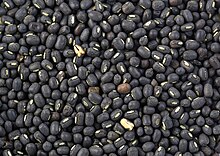| Vigna mungo | |
|---|---|
 | |
| Dry urad beans | |
| Scientific classification | |
| Kingdom: | Plantae |
| (unranked): | Angiosperms |
| (unranked): | Eudicots |
| (unranked): | Rosids |
| Order: | Fabales |
| Family: | Fabaceae |
| Subfamily: | Faboideae |
| Tribe: | Phaseoleae |
| Genus: | Vigna |
| Species: | V. mungo |
| Binomial name | |
| Vigna mungo (L.) Hepper | |
Black gram originated in India where it has been in cultivation from ancient times and is one of the most highly prized pulses of India. It has also been introduced to other tropical areas mainly by Indian immigrants.
It is an erect, sub-erect or trailing, densely hairy annual herb. The tap root produces a branched root system with smooth, rounded nodules. The pods are narrow, cylindrical and up to six cm long. The bean is boiled and eaten whole or, after splitting, made into dal; prepared like this it has an unusual mucilaginous texture. Ground into flour or paste, it is also extensively used in South Indian culinary preparation like dosa, idli, vada, and papadum. When used this way, the white lentils are usually used.
It is very nutritious and is recommended for diabetics, as are other pulses. It is very popular in the Punjabi cuisine of India and Pakistan where it is known as "sabit maash" an ingredient of dal makhani. In Tamil it is known as "ulunthu"(உளுந்து), in Telugu as "minumulu" (మినుములు), in Kannada as "Uddina Bele" (ಉದ್ದಿನ ಬೇಳೆ), and in Oriya as "Biri Dali".
The product sold as "black lentil" is usually the whole urad bean or urad dal. The product sold as "white lentil" is the same lentil with the black skin removed.
 Unknown
Unknown









0 komentar:
Post a Comment